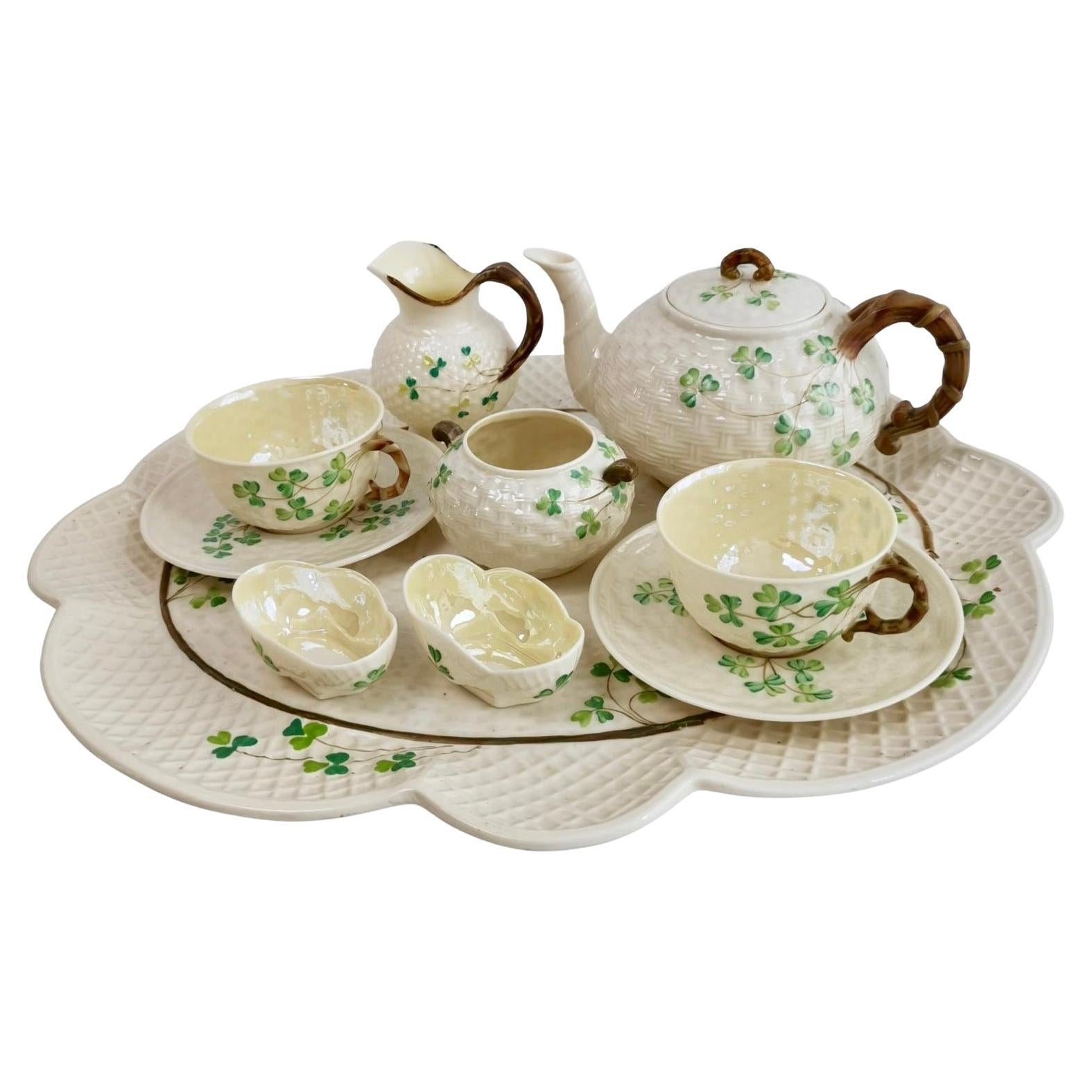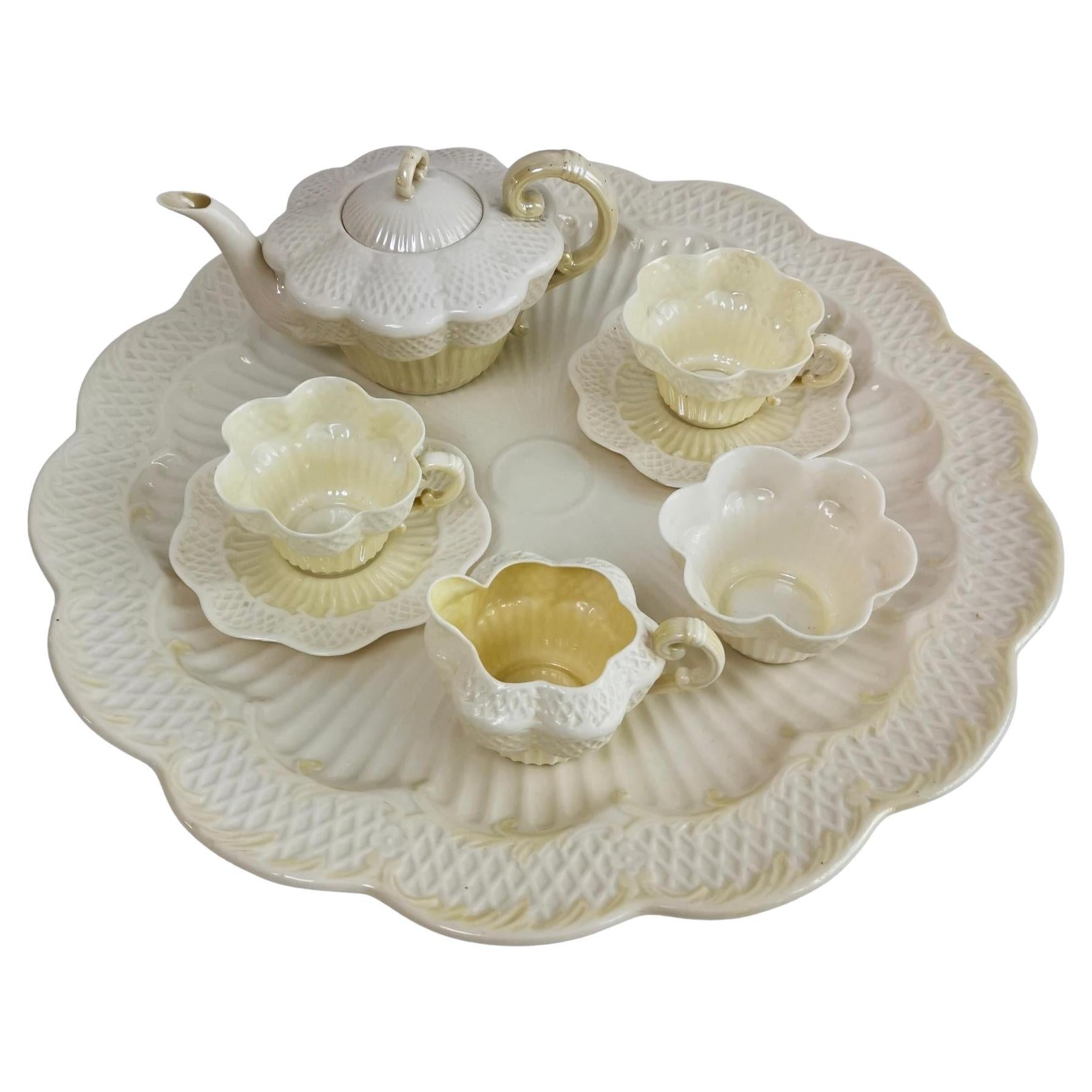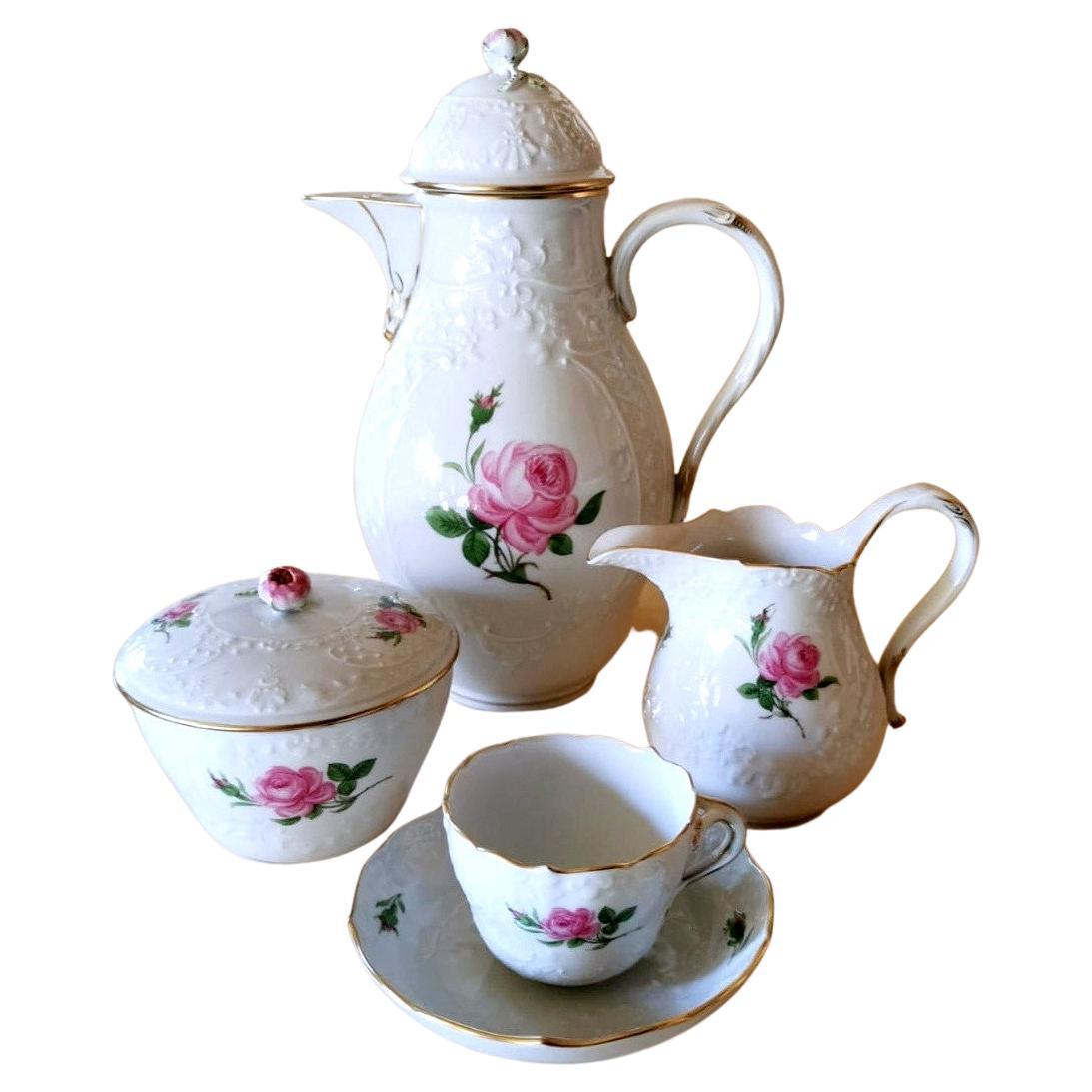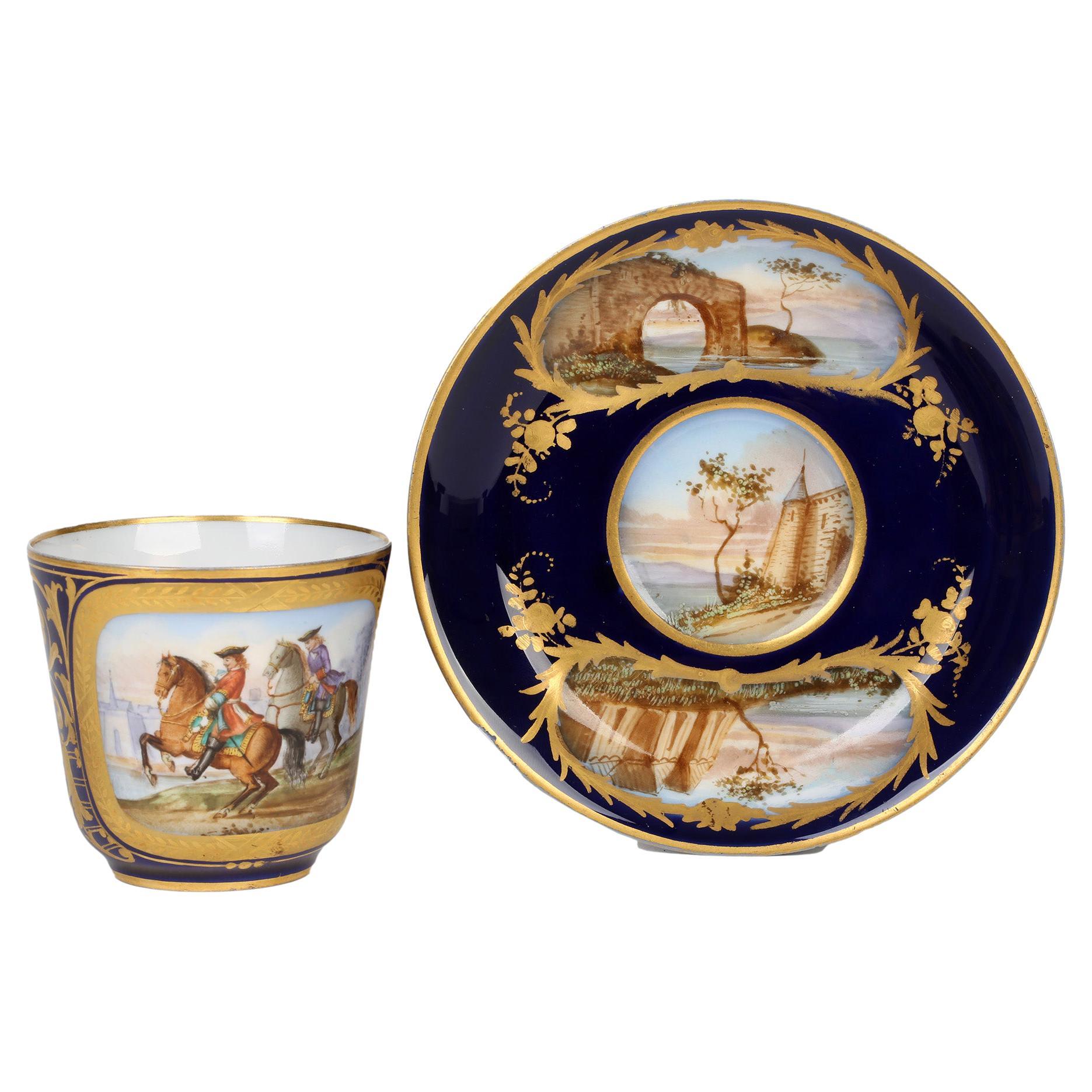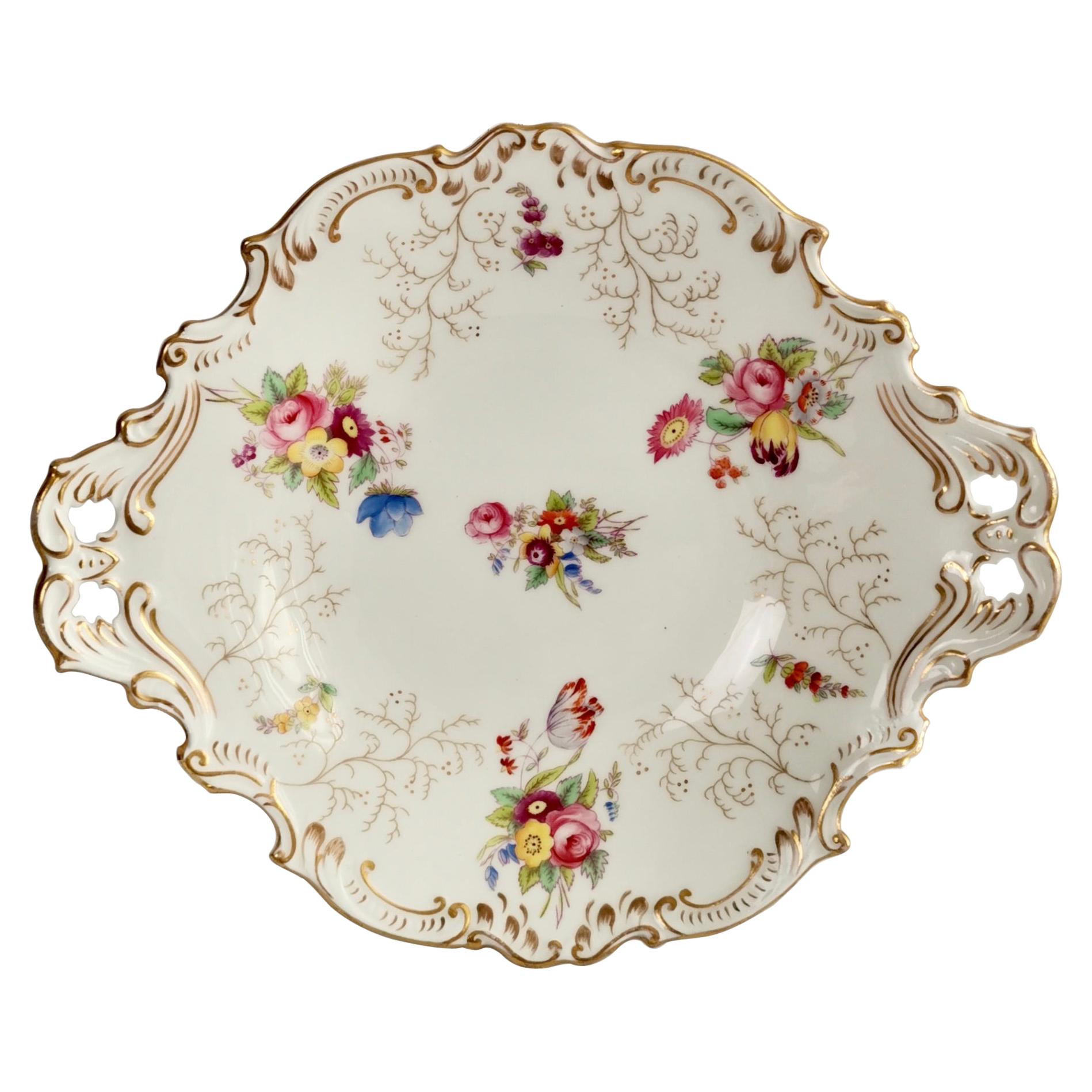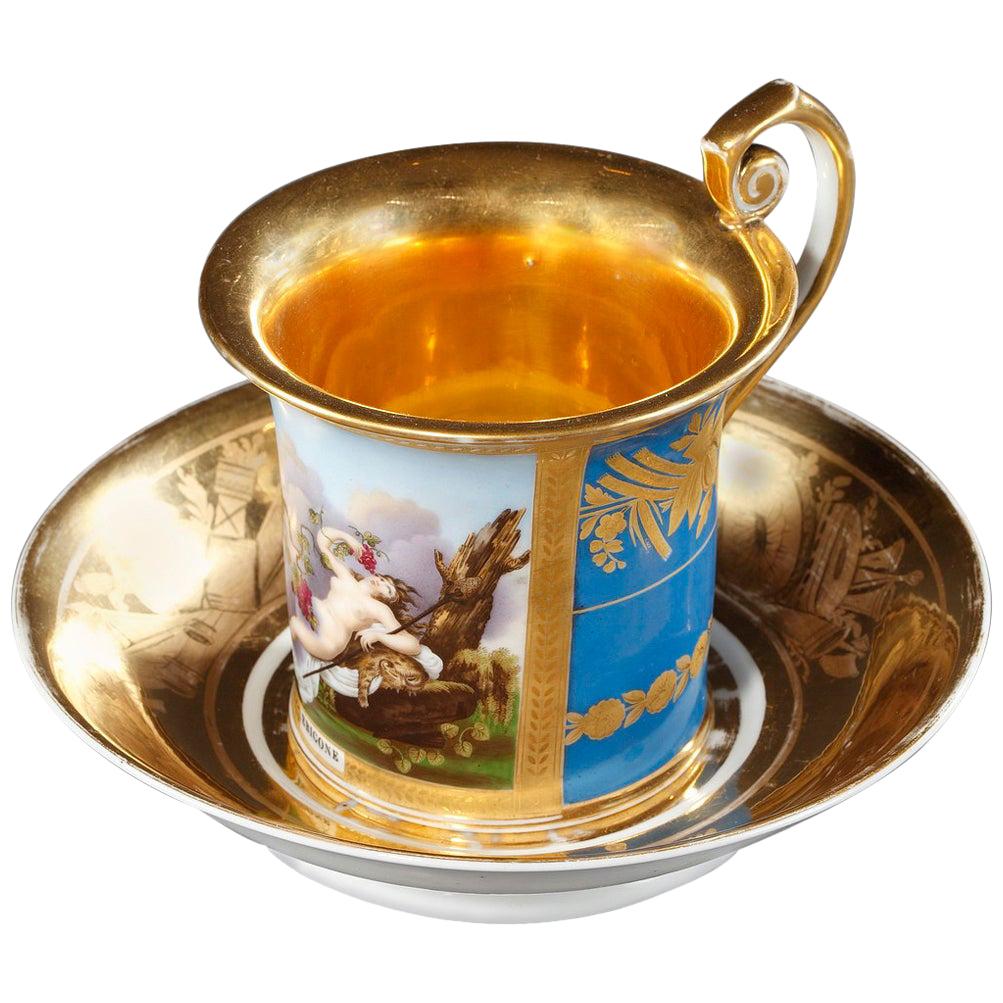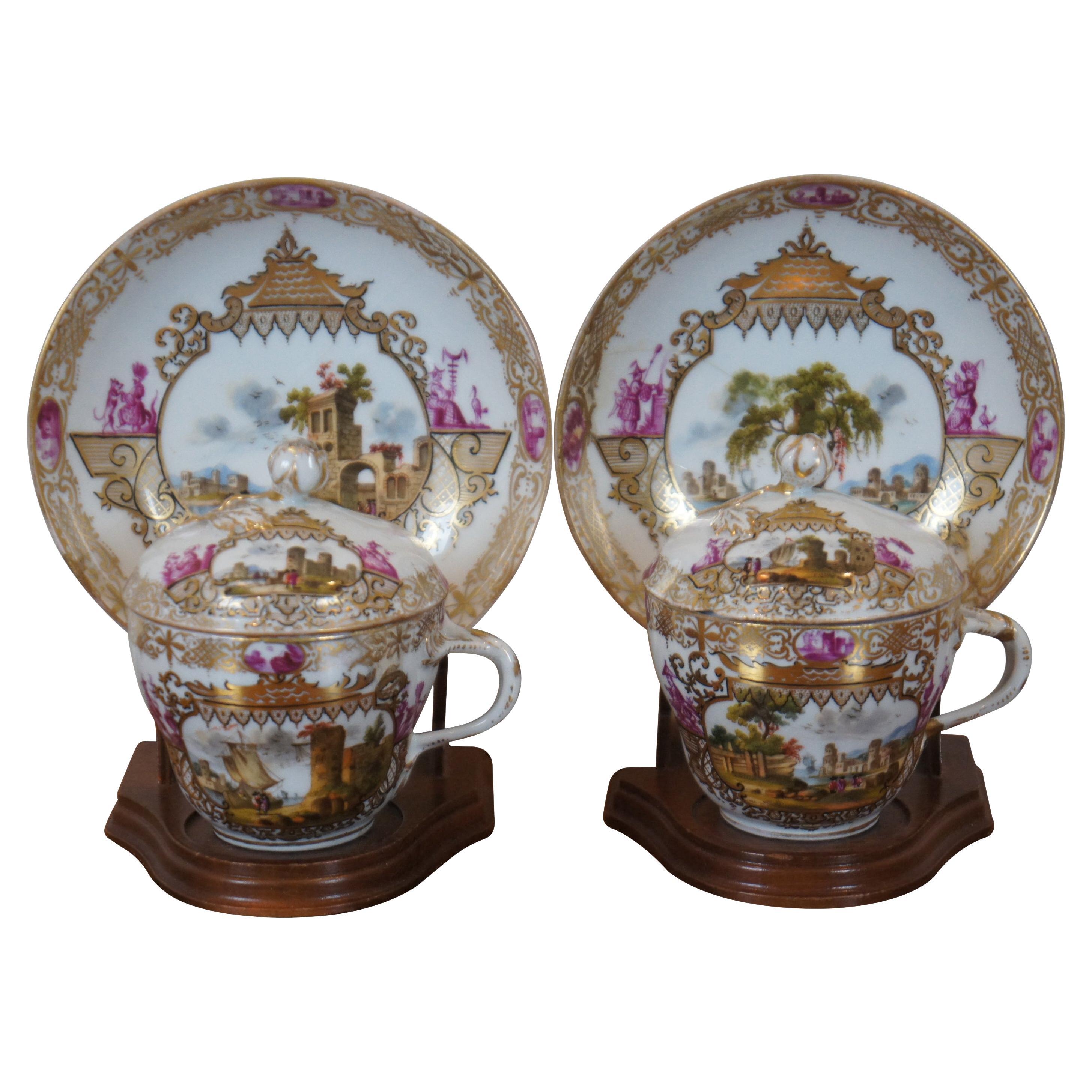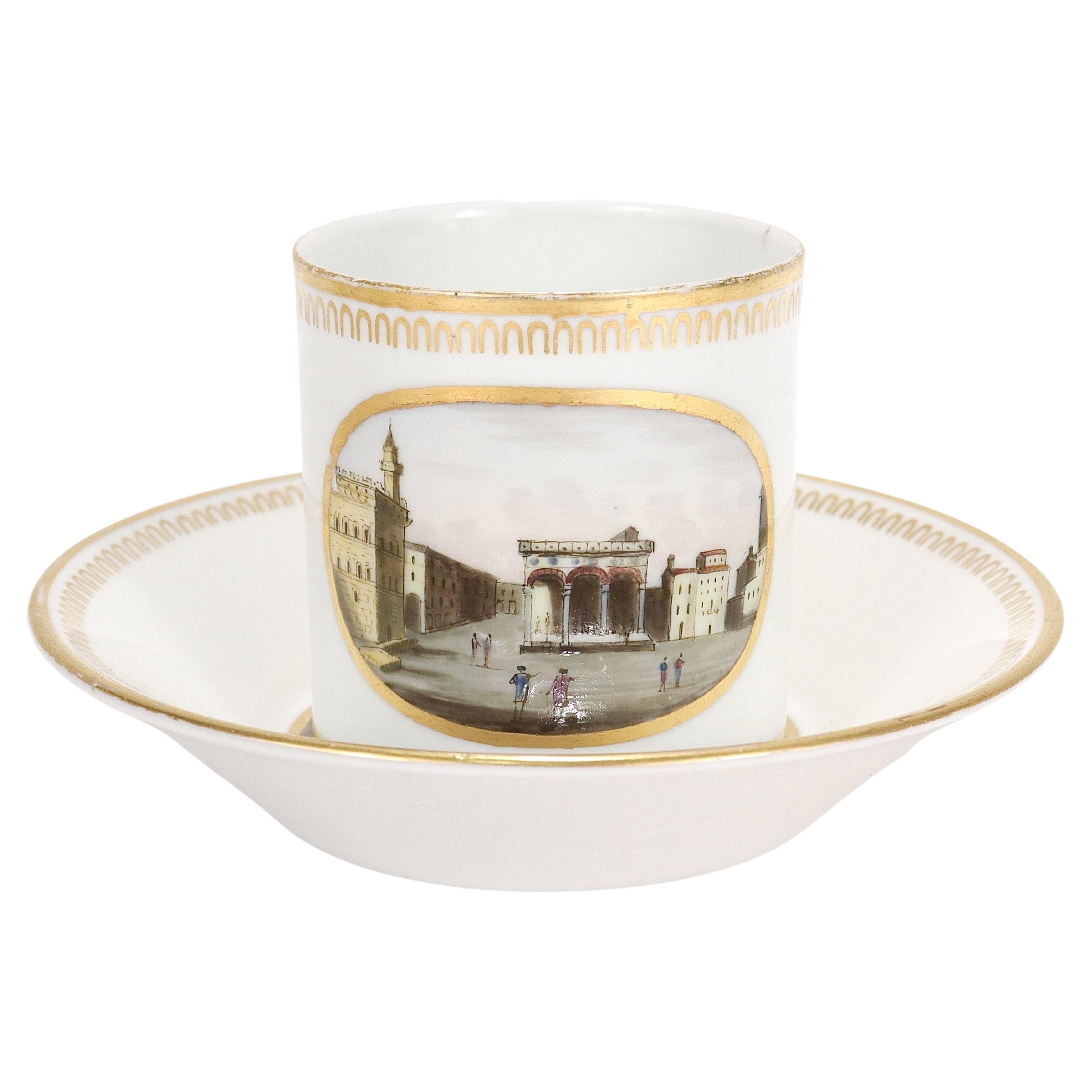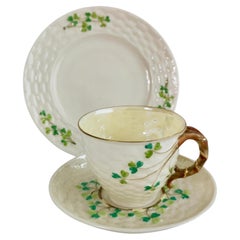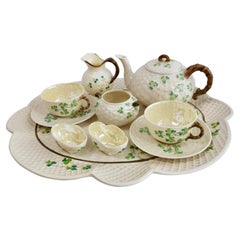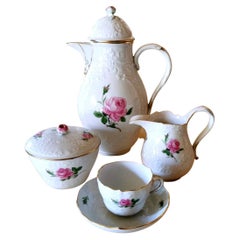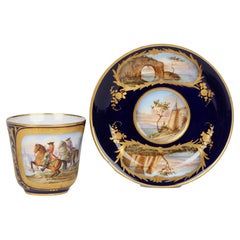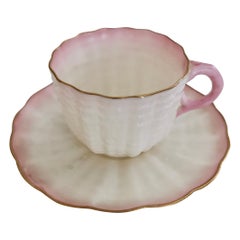
Belleek Porcelain Demitasse Cup, Soft Pink Tridacna, Victorian 1891-1926
View Similar Items
Want more images or videos?
Request additional images or videos from the seller
1 of 11
Belleek Porcelain Demitasse Cup, Soft Pink Tridacna, Victorian 1891-1926
About the Item
- Creator:Belleek Pottery Ltd. (Maker)
- Dimensions:Height: 1 in (2.54 cm)Width: 1 in (2.54 cm)Depth: 1 in (2.54 cm)
- Sold As:Set of 2
- Style:Victorian (Of the Period)
- Materials and Techniques:
- Place of Origin:
- Period:
- Date of Manufacture:1891-1926
- Condition:Wear consistent with age and use. No damage, crazing or repairs, a tiny glaze fault on saucer.
- Seller Location:London, GB
- Reference Number:Seller: A-BEL02b1stDibs: LU4805117206241
About the Seller
5.0
Gold Seller
These expertly vetted sellers are highly rated and consistently exceed customer expectations.
Established in 2016
1stDibs seller since 2019
210 sales on 1stDibs
Typical response time: 1 hour
More From This SellerView All
- Belleek Coffee Cup Trio, Shamrock Pattern, 1891-1926By Belleek Pottery Ltd.Located in London, GBThis is a very charming coffee cup trio made by Belleek in the Shamrock design, consisting of a coffee cup, a saucer and a little cake plate. It has the 2nd Black Mark, which was used between 1891 and 1926. Given the quality of the porcelain we think the date of production is probably closer to 1891 than 1926. If you ever thought Belleek fine china looks, sounds and feels unique, you are right. There is a back story to this extraordinarily fine Irish eggshell porcelain, which has an unusually high amount of "frit" and therefore is thinner and finer than any other china. Pottery in Belleek (in the now Northern-Irish area of Fermanagh) had started in 1849 with John Caldwell Bloomfield, who was a wealthy land owner. During the Irish famine...Category
Antique Late 19th Century Northern Irish Arts and Crafts Tea Sets
MaterialsPorcelain
- Belleek Cabaret Tea Set for Two, Cream Grass Pattern, Victorian 1863-1891By Belleek Pottery Ltd.Located in London, GBThis is a beautiful and very rare Belleek cabaret set in the Grass design, consisting of a teapot, two teacups and saucers, a milk jug and a lidded sugar bowl, all placed on a large tray. All items carry the 1st Black Mark, which was used between 1863 and 1891. It is extremely rare to come across an entire cabaret set of these antique items, particularly when in such fabulous condition, so this is a rare opportunity! If you ever thought Belleek fine china looks, sounds and feels unique, you are right. There is a back story to this extraordinarily fine Irish eggshell porcelain, which has an unusually high amount of "frit" and therefore is thinner and finer than any other china. Pottery in Belleek (in the now Northern-Irish area of Fermanagh) had started in 1849 with John Caldwell Bloomfield, who was a wealthy land owner. During the Irish famine...Category
Antique Late 19th Century Northern Irish Victorian Tea Sets
MaterialsPorcelain
- Belleek Cabaret Tea Set for Two, Shamrock Pattern, 1891-1946By Belleek Pottery Ltd.Located in London, GBThis is a rare and gorgeous Belleek cabaret tea service, or dejeuner set, in the famous Shamrock design, consisting of a teapot, two teacups and saucers, a milk jug, a sugar bowl, and a salt and pepper, all placed on a large matching tray. It is extremely rare to come across an entire cabaret set of these antique items, particularly when in such good condition, so this is a rare opportunity! If you ever thought Belleek fine china looks, sounds and feels unique, you are right. There is a back story to this extraordinarily fine Irish eggshell porcelain, which has an unusually high amount of "frit" and therefore is thinner and finer than any other china. Pottery in Belleek (in the now Northern-Irish area of Fermanagh) had started in 1849 with John Caldwell Bloomfield, who was a wealthy land owner. During the Irish famine...Category
Antique Late 19th Century Northern Irish Victorian Tea Sets
MaterialsPorcelain
- Belleek Cabaret Tea Set, Cream Cob Lustre, Erne, Victorian, 1890sBy Belleek Pottery Ltd.Located in London, GBThis is an extremely rare Belleek cabaret set for two, or "tête-à-tête", made in the Erne series brought out in the 1890s. The items carry the 2nd Black Mark, used between 1891 and 1926. The set consists of a teapot, a milk jug, a sugar bowl, two teacups and saucers, and a large matching tray. This set is very fine and with its restrained cream-white colour it would make a wonderful wedding gift! If you ever thought Belleek fine china looks, sounds and feels unique, you are right. There is a back story to this extraordinarily fine Irish eggshell porcelain, which has an unusually high amount of "frit" and therefore is thinner and finer than any other china. Pottery in Belleek (in the now Northern-Irish area of Fermanagh) had started in 1849 with John Caldwell Bloomfield, who was a wealthy land owner. During the Irish famine he realised that unless he would find a way for his tenants to make a profit off the land, they would starve. Agriculture had become impossible due to the agricultural diseases. This caused millions to starve and more millions to leave. As an amateur mineralogist, John Caldwell Bloomfield realised that his land had exactly the right mineral deposits to be used as clay for porcelain. He involved several investors and scientists and after many years of research, trial, error, the building of a railway line to import coal from England, and building a factory, the Belleek pottery resulted, employing the local people and soon producing the finest china made with clay from the Belleek area. What had started as a way to fend off famine among the local tenants had became a story of incredible success by the 1880s as Queen Victoria fell in love with the fine white china and the many homely, slightly bizarre but nature-loving designs; this was different from English tradition, yet it was very much to the taste of the British who had developed a real love for home-made fine china since it was introduced in the late 18th Century. Belleek not only brought out many tea services, but started a new tradition of intricately woven porcelain baskets. Soon the English nobility started to place big orders and the pottery is still flourishing today and selling its wares the world over, while in England most potteries have long disappeared. Belleek made many cabaret services, often called breakfast services or "tête-à-tête" services; these were used to carry breakfast tea up to the bedroom. Queen Victoria bought one in the Echinus style during a visit to the factory in the 1860s, and ever since Belleek's cabaret services have been in great demand. Nowadays there are very few of these left and it is rare to find a full service like this. The Erne series was named after the river right besides the Belleek factory. This river forms the border between the Republic of Ireland and Northern Ireland, with the factory on the Northern Irish end of the bridge at Belleek. The pattern seems to be a play on the baskets and nets of the fishermen who once fished the abundant trout and salmon on the river Erne and the lake that belongs to it. The items carry the second Black Mark, which was used between 1891 and 1926, however the very fine quality of the porcelain indicates that most pieces of the set are more likely to be from the 1890s than from the 20th Century. You will see that the shade of cob lustre is different on each item; this is normal for Belleek tea sets...Category
Antique Late 19th Century Northern Irish Victorian Tea Sets
MaterialsPorcelain
$3,540 Sale Price20% OffFree Shipping - Coalport Porcelain Serving Dish, White with Flowers, Victorian, 1891-1926By Coalport PorcelainLocated in London, GBThis is beautiful serving dish made by Coalport some time between 1891 and 1926. The dish is bright white with very fine printed flowers that have been carefully hand coloured. ...Category
Early 20th Century English Victorian Serving Bowls
MaterialsPorcelain
$280 Sale Price20% OffFree Shipping - Bow Porcelain Orphaned Coffee Cup, Famille Rose Peony, circa 1755By Bow PorcelainLocated in London, GBThis is a very charming orphaned coffee cup made by the Bow Porcelain factory in about 1755. The cup is decorated in a Chinese "famille rose" peony pattern. This cup would have been part of a large tea service, and the tiny size shows how expensive coffee was in the 18th Century. The Bow Porcelain Factory was one of the first potteries in Britain to make soft paste porcelain, and most probably the very first to use bone ash, which later got perfected by Josiah Spode to what is now the universally used "bone china". Bow was the main competitor of the Chelsea Porcelain Factory, but where Chelsea made very fine slipcast porcelain, Bow made a different soft paste porcelain that tended to be softer and could be pressed into moulds. Bow served a larger public generally at lower prices. The factory was only in operation between 1743 and 1774, after which the tradition got incorporated into some of the later famous potteries such as Worcester and Derby. The cup is unmarked, which is normal for Bow items of this era. Condition report the cup is in excellent condition without any damage or repairs. There are various glazing imperfections, which are quite normal for porcelain of this era. Antique British porcelain...Category
Antique 1750s English Rococo Tea Sets
MaterialsPorcelain
You May Also Like
- Meissen Porcelain Pink Roses Coffee Service and Embossed Decorations '11 Cups'By Meissen PorcelainLocated in Prato, TuscanyWe kindly suggest you read the whole description, because with it we try to give you detailed technical and historical information to guarantee the authenticity of our objects. Rare Meissen porcelain coffee service in Biedermeier style; the set consists of a teapot, a sugar bowl, a milk jug, and 11 cups with plate; the various pieces are made of fine hand-painted hard white porcelain with the "Pink Roses" decoration enriched on all items with sumptuous unpainted relief decorations. Unlike the simple and quite common "Pink Roses", this model is very rare, prestigious, and sought after, therefore even more expensive; in fact, the objects with this relief decoration, much more particular and detailed than others, were fired three times, while those with only the "Pink Roses" decoration only twice. Moreover, the execution of this ornamental motif with delicate and graceful flowers was entrusted only to the most experienced and skilled painters, those in possession of the prestigious diploma obtained at the "School of Drawing of Meissen" established since 1764. The knobs of the teapot and sugar bowl represent two harmonious and graceful rosebuds, also handmade; the edges of the cups and saucers are scalloped and finished with pure gold as well as the other decorations of the teapot and sugar bowl. All pieces bear the original Meissen trademark (two crossed swords) and from the enclosed list it can be stated with certainty that our service was produced between 1934 and 1944; moreover, on the objects the model is handwritten (61/106), this wording makes the artifacts even more precious and appreciated as they preserve all the characteristics of the author's calligraphy. Meissen porcelain was created in the castle of Albrechtsburg, in Meissen, a small town in Saxony near Dresden, in 1710, at the behest of Augustus the Strong (1670-1733), Prince-Elector of Saxony and King of Poland, who wanted to start production after the studies and experiments of his alchemist Bottger. Bottger discovered the formula for porcelain, in fact at that time, only the Chinese and Japanese had the recipe to create this wonderful material; Meissen was, therefore, the first porcelain produced in Europe! Bottger never revealed his formula to anyone, only a certain stage was known to the workers; we do not know, even today, in what proportions the different components are mixed; this is the great secret that allowed the famous brand to be considered the best in the world, Meissen porcelain is given the nickname of "white gold"! Through the years, Meissen has perfected its hard-paste products with high-temperature firing during its glazing. Meissen's porcelain patterns have been copied by many other manufacturers around the world such as Royal Copenhagen, Dresden, Herend, and many others, but Meissen's porcelain glaze maintains its quality over time and is superior to all (plates will not scratch with prolonged use of cutlery!). This is why even old Meissen...Category
Mid-20th Century German Biedermeier Porcelain
MaterialsPorcelain
$4,841 Sale Price / set20% Off - Le Tallec Set of 4 Demitasse Cups and Matching Tray with Profuse Raised GildingLocated in Boston, MAThis is an exquisite Le Tallec set that includes four demitasse cups and saucers with a tray with a matching pattern. All the cups and saucers and the tray are embellished in raised profuse gilding with curves and scrolls in a rococo style. The tray is 13.5 inches in diameter. This demitasse set is very rare and would be a wonderful addition to any coffee lover or demitasse collector. Price of Le Tallec set-$1500.00. Camille Le Tallec was born in Paris in 1906. In 1929, he graduated from the Ecole du Louvre. In 1930, he opened his studio in Belleville, Paris, which became the Atelier Le Tallec. At his studio, his goal was to paint his porcelain pieces beautifully like Vincennes or Sevres porcelains. Most of the Le Tallec boxes...Category
Vintage 1950s French Rococo Tea Sets
MaterialsPorcelain
- Sevres Hand Painted Matched Porcelain Cabinet Cup and SaucerBy Manufacture Nationale de SèvresLocated in Bishop's Stortford, HertfordshireA fine antique French matched hand painted porcelain cabinet cup and saucer painted with various scenes by Sevres and dating from the latter 19th century. ...Category
Antique Late 19th Century French Late Victorian Tea Sets
MaterialsPorcelain
- Royal Doulton White Blue Gold Coffee or Tea Demitasse Cup & Saucer, circa 19th CBy Royal Daulton, Davis Collamore & Co Ltd. 1Located in New York, NYA very special English Royal Doulton for luxury retailer Davis Collamore & Co LTD, espresso coffee or tea demitasse cup and saucer set, ci...Category
Antique Late 19th Century English Tea Sets
MaterialsGold
- Early 19th Century German Porcelain CupLocated in Paris, FRPorcelain cup decorated with a scene depicting Erigone lying down on a cheetah skin and eating grapes. In Greek mythology, Dionysus (also known as Bacchus...Category
Antique Early 19th Century German Empire Porcelain
MaterialsPorcelain
$2,310 / set - 2 Antique Meissen German Porcelain Lidded Chocolate Tea Cups & Saucers on StandsBy Meissen PorcelainLocated in Dayton, OH"Pair of exqusite antique 19th century Meissen porcelain demitasse chocolate cups with lids and saucers, decorated with pink and gold borders and landscapes with stone buildings. Both are beautifully displayed on wooden stands. Provenance : Jerome Schottenstein Estate, Columbus Ohio. Jerome was was an American entrepreneur and philanthropist, co-founder of Schottenstein Stores Corp. The Schottenstein family were Lithuanian immigrants who began an extensive business empire in the late 19th Century. Schottenstein Stores owns stakes in DSW and American Signature Furniture...Category
Antique Late 19th Century Victorian Tea Sets
MaterialsPorcelain, Hardwood
Recently Viewed
View AllMore Ways To Browse
Antique Beautiful Tea Cups
Antique Chinese Cup Saucer
Cup Saucer Antique China
Vintage Cup and Saucers
Antique China Tea Cup
Chinese Antique Tea Cups
Antique Tea Cups From England
Antique Tea Cups Made In England
China White Cup Saucer
Tea Set White And Black
Antique Cup And Saucer Signed
Antique Sea Porcelain
Vintage Antique Tea Cups
Antique And Vintage Furniture Ltd
18th Century Tea Cup
Fluted Pottery
Silver Gilt Lined Tea Cups And Saucers
Antique English Porcelain Tea Sets


